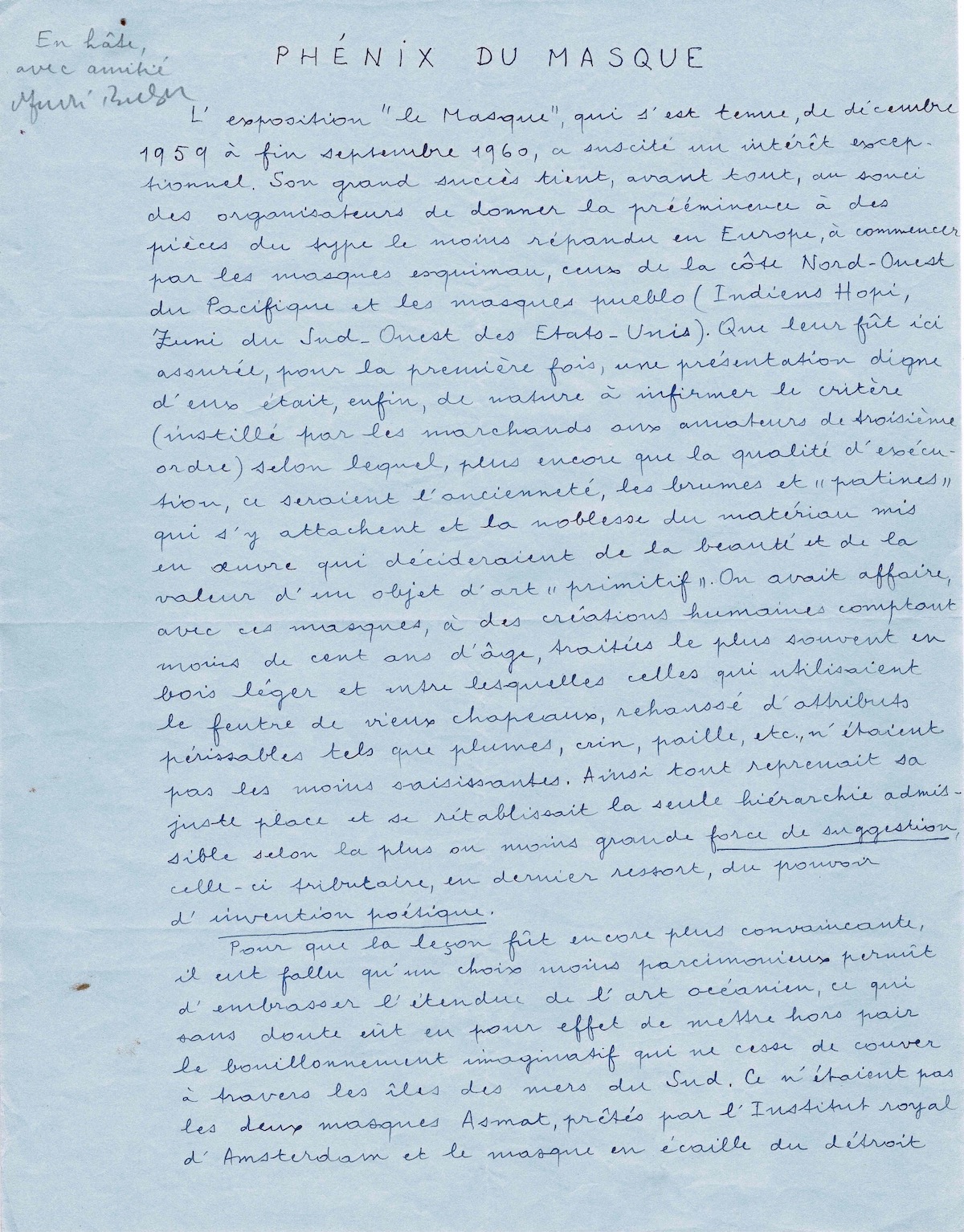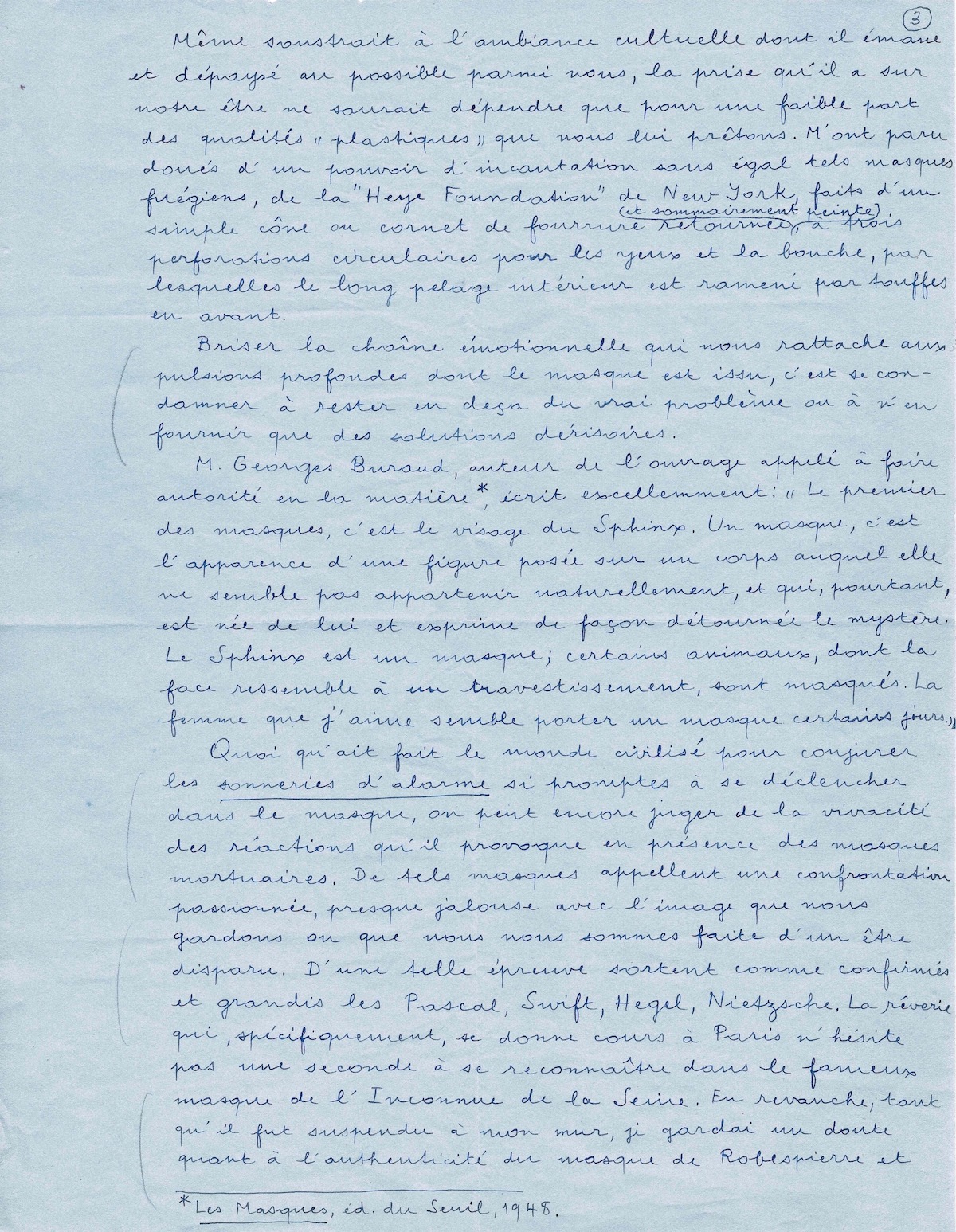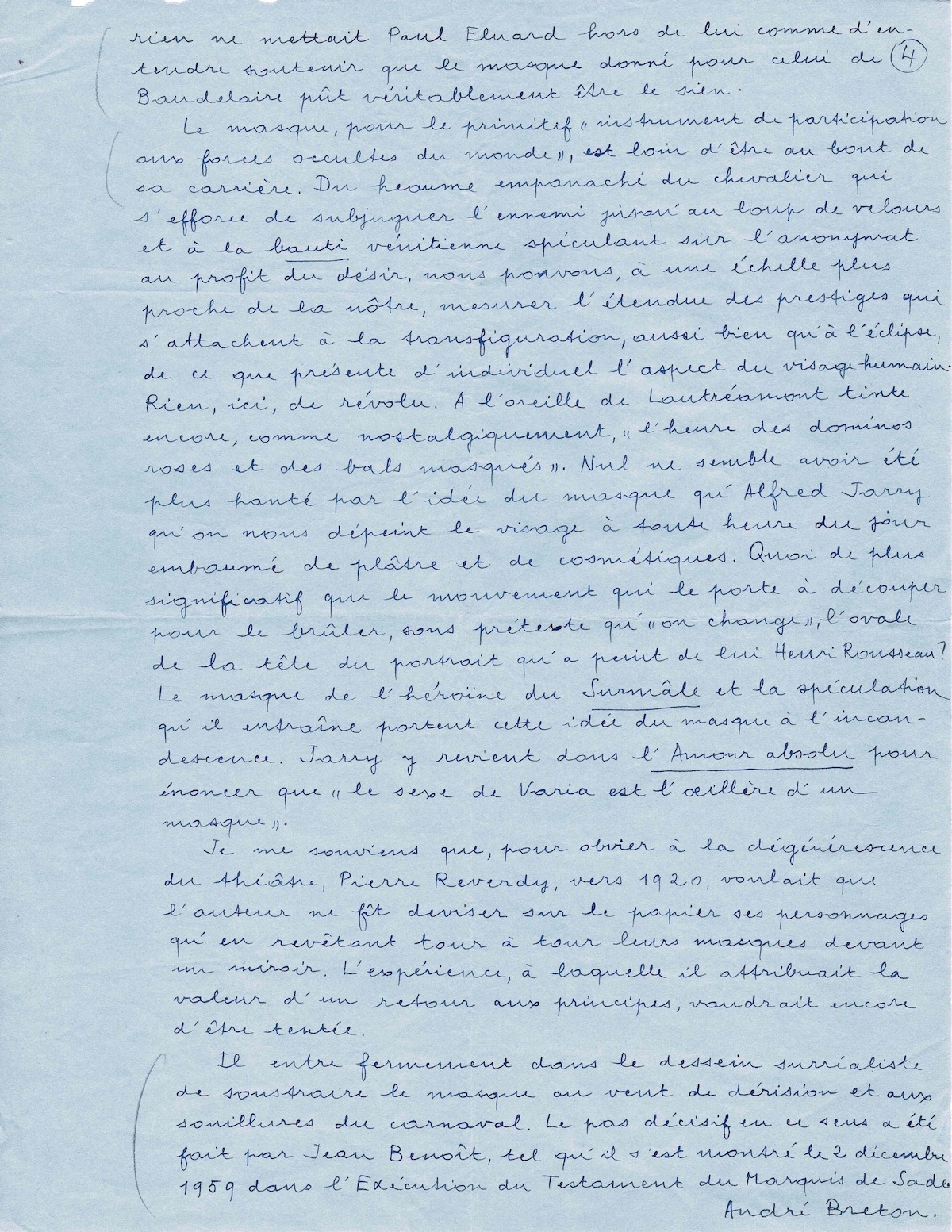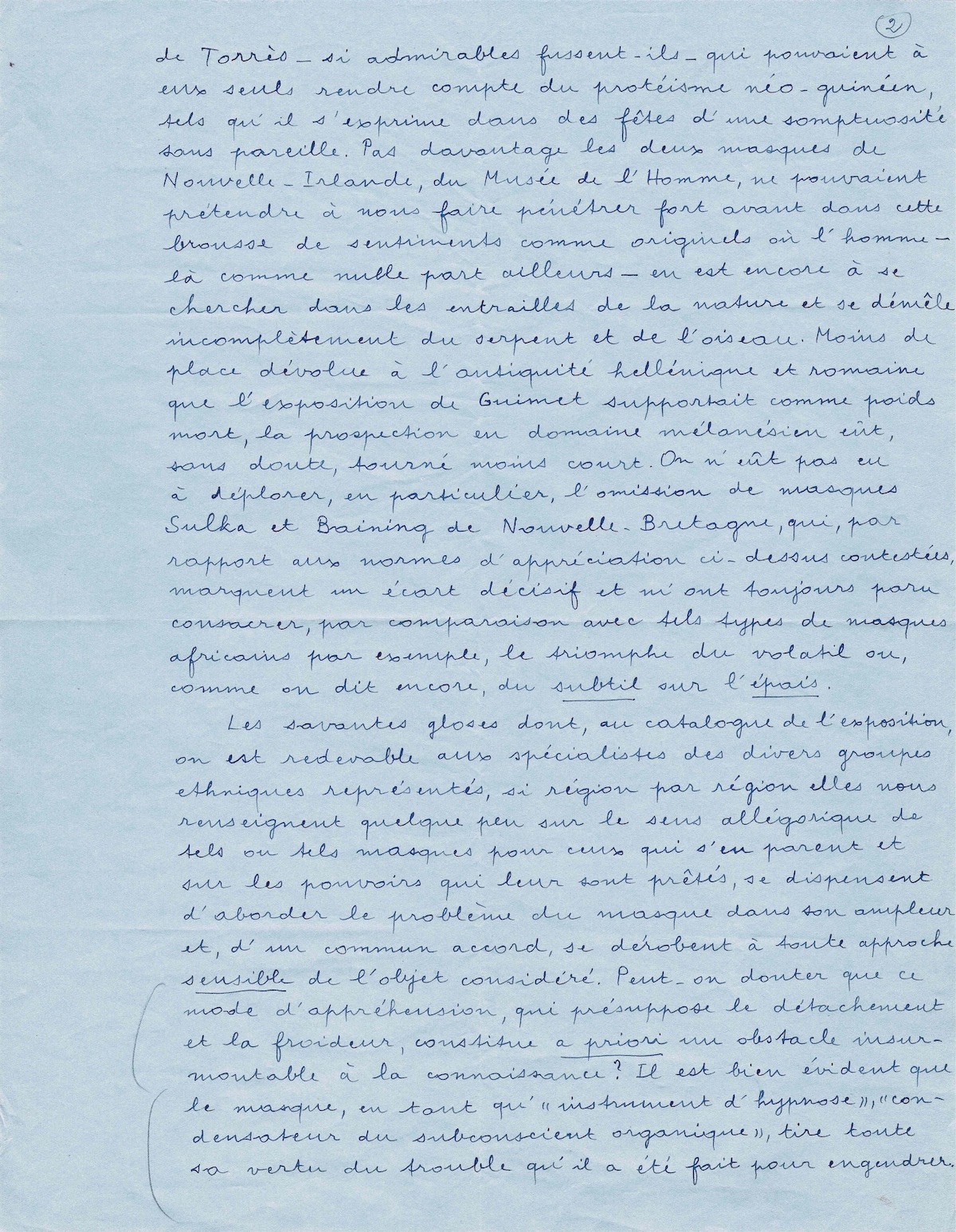André Breton (1896.1966)
Autograph manuscript signed – PHOENIX DU MASQUE.
Four pages in-4° on blue paper. Slnd [December 1960]
Ensign signed by Breton at the head of the manuscript [probably to Gualtieri di San Lazzaro]
“It firmly enters into the surrealist intention of shielding the mask from the wind of derision and the stains of carnival. »
As an informed connoisseur, André Breton analyzes a posteriori the success of the exhibition “Le Masque” which was held at the Guimet museum during the first half of 1960. The surrealist Hérault, an inveterate collector of primitive art, is praised to the skies, in this 20th century art magazine (founded by Gualtieri di San Lazzaro), the hypnotic virtues of adornment and the mask, doors open to the regions of the unconscious, constituting a form of surrealist ideal.
_________________________________________
“In haste, with friendship, André Breton. »
PHOENIX OF THE MASK
The exhibition “The Mask”, which was held from December 1959 to the end of September 1960, aroused exceptional interest. Its great success is due, above all, to the organizers' concern to give prominence to pieces of the least common type in Europe, starting with Eskimo masks, those from the North-West Pacific coast and Pueblo masks (Hopi Indians). , Zuni of the Southwestern United States). That they were assured here, for the first time, of a presentation worthy of them was, finally, likely to invalidate the criterion (instilled by dealers in third-rate amateurs) according to which, even more than the quality of execution, it would be the age, the mists and “patinas” attached to it and the nobility of the material used which would decide the beauty and value of a “primitive” art object. We were dealing, with these masks, with human creations less than a hundred years old, most often made of light wood and including those which used the felt of old hats, enhanced with perishable attributes such as feathers, horsehair , straw, etc., were not the least striking. Thus everything returned to its rightful place and the only admissible hierarchy was reestablished according to the greater or lesser force of suggestion , the latter dependent, in the last resort, on the power of poetic invention .
For the lesson to be even more convincing, it would have been necessary for a less parsimonious choice to embrace the breadth of Oceanian art , which would undoubtedly have had the effect of setting apart the imaginative ferment which continues to flourish. brood across the South Sea islands. It was not the two Asmat masks, loaned by the Royal Institute of Amsterdam, and the tortoiseshell mask from the Torres Strait – however admirable they were – which could alone account for New Guinean proteism, such as he expresses himself in parties of unparalleled sumptuousness. Nor could the two masks from New Ireland, from the Musée de l'Homme, claim to take us far into this bush of feelings as original where man – there as nowhere else – is still searching for himself. in the bowels of nature and incompletely disentangles itself from the snake and the bird. With less space devoted to Hellenic and Roman antiquity, which Guimet's exhibition supported as dead weight, prospecting in the Melanesian domain would undoubtedly have been less short-lived. We would not have had to deplore, in particular, the omission of Sulka and Braining masks from New Britain, which, compared to the standards of appreciation contested above, mark a decisive deviation and have always seemed to me to consecrate , in comparison with such types of African masks for example, the triumph of the volatile or, as they still say, of the subtle over the thick .
The learned glosses for which, in the exhibition catalogue, we are indebted to the specialists of the various ethnic groups represented, if region by region they inform us somewhat about the allegorical meaning of this or that masks for those who adorn themselves with them and on the powers attributed to them refrain from addressing the problem of the mask in its scope and, by mutual agreement, shy away from any sensitive to the object considered. Can we doubt that this mode of apprehension, which presupposes detachment and coldness, constitutes a priori an insurmountable obstacle to knowledge? It is quite obvious that the mask, as an “instrument of hypnosis”, “condenser of the organic subconscious”, draws all its virtue from the disorder it was made to generate.
Even removed from the cultural atmosphere from which it emanates and as disorientated as possible among us, the hold it has on our being can only depend to a small extent on the “plastic” qualities that we attribute to it. Such Fregean masks, from the “Heye Foundation” in New York, seemed to me to have an unequaled power of incantation, made of a simple cone or cone of fur turned over and summarily painted, with three circular perforations for the eyes. and the mouth, through which the long inner coat is brought forward in tufts.
Breaking the emotional chain that connects us to the deep impulses from which the mask comes is to condemn ourselves to staying below the real problem or to providing only paltry solutions.
Mr. Georges Buraud, author of the authoritative work on the subject [Les Masques, ed. du Seuil, 1948], writes excellently: “ The first of the masks is the face of the Sphinx. A mask is the appearance of a figure placed on a body to which it does not seem to naturally belong, and which, however, is born from it and expresses the mystery in an unusual way. The Sphinx is a mask; certain animals, whose strength resembles a disguise, are masked. The woman I love seems to wear a mask some days. »
Whatever the civilized world has done to ward off the alarm bells so quick to go off in the mask, we can still judge the liveliness of the reactions it provokes in the presence of death masks. Such masks call for a passionate, almost jealous confrontation with the image that we keep or that we have created of a disappeared being. From such an ordeal emerge as confirmed and grown the Pascal, Swift, Hegel, Nietzsche. The reverie which, specifically, takes place in Paris does not hesitate for a second to recognize itself in the famous mask of the Unknown Woman of the Seine. On the other hand, although it was hung on my wall, I will remain in doubt as to the authenticity of Robespierre's mask and nothing put Paul Éluard beside himself like hearing that the mask given for that of Baudelaire could truly to be his.
The mask, for the primitive “instrument of participation in the occult forces of the world”, is far from the end of its career. From the plumed helm of the knight who strives to subjugate the enemy to the velvet wolf and the bauti speculating on anonymity for the benefit of desire, we can, on a scale closer to ours, measure the extent of the prestige which attaches to the transfiguration, as well as to the eclipse, of what is individual in the aspect of the human face. Nothing is over here. In Lautréamont's ear still rings, as if nostalgically, “the time of pink dominoes and masked balls”. No one seems to have been more haunted by the idea of the mask than Alfred Jarry, whose face is depicted at all hours of the day embalmed with plaster and cosmetics. What could be more significant than the movement which leads him to cut out and burn it, under the pretext that “we are changing”, the oval of the head of the portrait that Henri Rousseau painted of him? The mask of the heroine of Le Surmâle and the speculation it entails bring this idea of the mask to incandescence. Jarry returns to this in Absolute Love to state that “Varia's sex is the blinder of a mask”.
I remember that, to prevent the degeneration of the theater, Pierre Reverdy, around 1920, wanted the author to only have his characters speak on paper by putting on their masks in turn in front of a mirror. The experience, to which he attributed the value of a return to principles, would still be worth trying.
He firmly enters into the surrealist intention of shielding the mask from the wind of derision and the stains of carnival. The decisive step in this direction was taken by Jean Benoît, as he showed himself on December 2, 1959 in the Execution of the Testament of the Marquis de Sade. André Breton. »
_________________________________________
Bibliography:
Phoenix of the mask, André Breton, Cavalier perspective, Complete works.
Writings on art and other texts , Bibliothèque de la Pléiade, p. 990-996.
20th century , New series, n°15, Christmas 1960.




